Features and installation of kitchen hoods with ventilation outlet

Hoods with ventilation ducts are widely used in the arrangement of kitchen work areas and are in high demand. The devices allow you to completely renew the air volume of the room and prevent greasy drops, moisture and gas combustion products from settling on the walls and ceiling.
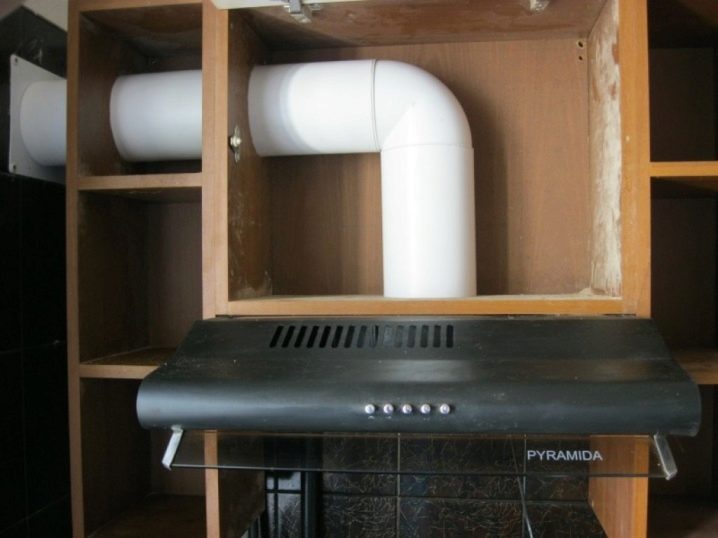
Specifications
Unlike closed-cycle hoods operating according to the scheme: intake of polluted air - run through a filter system - removal of the cleaned masses into the room, devices with a vent into the ventilation remove air outside. This technology allows you to quickly clear the space from cooking food odors and does not require regular filter replacement. For large kitchens, large models are provided, equipped with two motors and suitable for use in catering establishments.

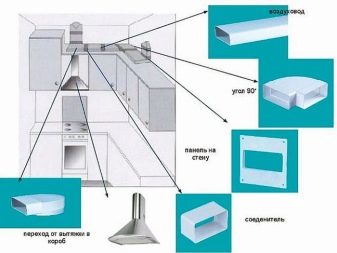
Constructively, hoods with ventilation duct consist of a body, a control panel, a coarse filter - grease catcher, and an air duct that goes into the ventilation duct.
The body of the models can be made of several materials.
- The most budgetary option is metal appliances painted with heat and moisture resistant enamels. Such models require careful maintenance and careful operation. The advantages of such cases include an attractive appearance, and the disadvantage is the tendency to scratches under mechanical stress, and enamel clouding over time.
- The tempered glass hoods are distinguished by their moderate cost and stylish appearance. The downside of such products is their demand for regular and painstaking care, which requires some skill and time. The fact is that on the surface of glass, especially painted in dark colors or tinted, fingerprints, water drops and stains are very clearly visible. Therefore, washing such a case requires the use of a special liquid for glass, patience and dexterity.
- The most spectacular and expensive are the chrome-plated stainless steel models. The devices are distinguished by their lightness of design and graceful forms. The products do not require painstaking care and retain their original appearance throughout the entire service life.






All hoods are equipped with control panels, which can be push-button or touch-sensitive. Mechanical panels are more understandable and familiar to older people. The buttons on such models are located on the front side, making it easy to set the desired mode. The touch panels are modern and comfortable. They are equipped with temperature and humidity sensors, changing which automatically changes the operating mode of the device. The hood is programmed using touch control only once - when it is installed. Further, the device works in autonomous mode and does not require constant adjustment.


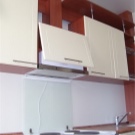



Air ducts installed on hoods are represented by corrugated pipes and plastic ducts. The former have a circular cross-section, are easy to install and have good flexibility. Installation is carried out using clamps supplied with the device. The advantage of the corrugation is the ability to give the pipe any bending radius, and the disadvantages include noisy work and the likelihood of fat settling on the inner folds of the pipe.Plastic air ducts can have both round and square cross-sections, are produced mainly in white and fit perfectly into the interior. The pluses include an absolutely flat inner surface, which facilitates the passage of air at a higher speed, and a low noise level. The downside is the lack of flexibility and the need to use connecting fittings, such as elbows and adapters, during installation.




Two types of filters are installed on the hoods. The external metal filter does not require replacement and deposits up to 95% of grease and dirt on its surface. Removal of contaminants is done by washing the grill with any detergent that breaks down fat. The second type of filters is represented by replaceable synthetic traps, which are thrown away after heavy contamination and replaced with new ones.
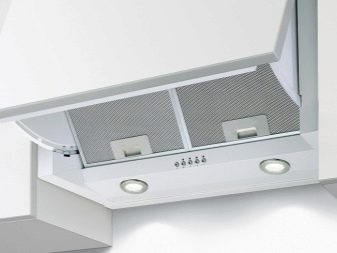

Advantages and disadvantages
High consumer demand for vented models due to a number of indisputable advantages of these devices.
- Due to the removal of polluted air masses to the street, the degree of room cleaning is almost 100%. This is almost 30% higher than the efficiency of closed-loop units operating on the principle of filtration.
- The absence of a filter system in the hood design eliminates the need for their regular replacement. This greatly facilitates the maintenance of the device and significantly saves money.
- The aesthetic appearance and neat forms of the unit allow it to be installed in any kitchen style, without fear of cluttering up the space and spoiling the interior.
- The high performance of the hoods is due to the presence of a coarse filter with minimal resistance. This allows steam and smoke to freely leave the room without lingering in the pre-filtration zone.

The disadvantages of devices include the complexity of installation, which is associated with the need for air duct equipment, and the presence of noise during the operation of the unit. In addition, for the correct and efficient operation of the device, a sufficiently good draft is required, in the absence of which it becomes necessary to install powerful fans. In addition, in houses that are not equipped with ventilation ducts, you will have to gouge the wall and independently form an opening for the air duct.

Views
In the modern market of ventilation systems, exhaust hoods with outlet to ventilation are presented in a wide variety. The models differ from each other in terms of installation and power.
According to the installation method, there are five versions.
- Hinged units are usually presented in standard and flat models. Appliances are fixed under a shelf or wall cabinet, hanging above the hob. They are installed in small kitchens, and are distinguished by their compact size and modern design.
- Wall mounted models are characterized by a wide assortment with a large selection of colors and designs. They are hung on a section of the wall located above an electric or gas stove.


- Insular the devices are designed for spacious rooms and are installed by hanging from the ceiling above the hob. They are used in cases where the hob is installed in the middle of the room and does not have an abutment to the wall. The fixing of the device to the ceiling is carried out using a steel cable.
- Corner models are intended for kitchens in which the stoves are located in the corner, and the use of other types of hoods is impractical. The devices have a stylish design and look very interesting.
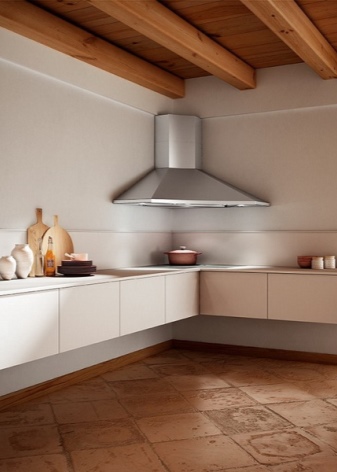
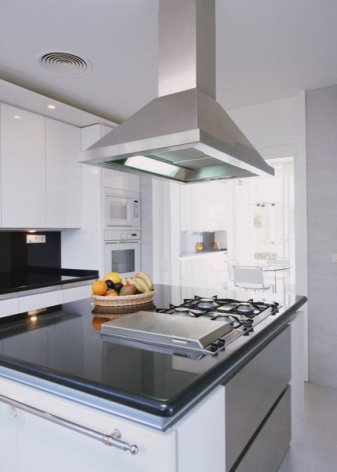
- Embedded hoods are used if the dimensions of the room suggest their placement in the case of cabinets or decorative boxes. Such models are selected individually and strictly according to the size of the cabinet furniture. Due to their integration into kitchen sets, they are a very common type.
- Fireplace the models belong to wall-mounted appliances, but for their unusual design and similarity to real fireplaces, they were singled out into a separate group.
- Dome household hoods are also popular with consumers. They can be angled or wall-mounted, and are capable of almost instantly removing contaminated air masses through the ventilation shaft to the street. However, due to their low power, they are used only for domestic needs. In public catering premises, this type of hood is ineffective.


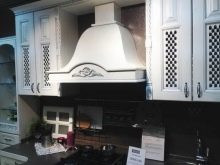
By their design, the hoods can have a one-piece or telescopic body. The first are traditional models, with constant dimensions and complete design. Telescopic devices are equipped with a pull-out panel that can double the working area of the hood. This type of unit is an effective solution for small areas, and allows you to install a full-fledged exhaust equipment without losing part of the space or cluttering it.

In terms of power, the units are divided into household single-engine and powerful twin-engine models. The former are installed in the kitchens of apartments and houses, while the latter are used in cafes, restaurants, pizzerias and other catering establishments.
Functionality
In addition to the basic mode of removing polluted air, hoods with ventilation ducts are equipped with a number of additional options. For example, many models have lighting for the work area. The brightness and direction of the beam are independently adjustable, which is very convenient when placing the hood in studio apartments: the lighting function allows you to cook food without turning on a large light. The most technologically advanced models are equipped with motion sensors that respond to the approach of a person and automatically turn on the light.

In more expensive hoods, halogen lamps are installed as a light source., while cheaper models are equipped with incandescent bulbs. Light from halogen lamps can be diffused or focused at one point at the request of the consumer. Incandescent lamps operate in a stable mode and can only slightly change the brightness. In addition to the lighting option, some models are equipped with a timer that allows you to control the cooking time and simplify this process.

Selection criteria
One of the most important indicators of the efficiency of the hood is its performance, which indicates how much air the device can pass through itself in one hour. The calculation of this parameter is individual for each kitchen and can be determined independently. To do this, the volume of the room should be multiplied by 10. The resulting value will indicate the performance of the device required for a given area.

Some sources recommend multiplying this number by a factor of 1.3, and, based on the resulting value, purchase the unit. The factor is based on the maximum air pollution and the length of the duct, therefore, the productivity calculated by this method is 15% higher than that obtained as a result of the initial calculations. The need for this margin is due to the fact that the device often works at the limit of its capabilities, which is why it quickly wears out and makes a lot of noise.

The second criterion when choosing a model is to determine the desired size. In this case, it is necessary to be guided by the area of the hob, which should completely overlap with the area of the working area of the hood. For small-sized kitchens, it is better to choose the telescopic option: when folded, it takes up very little space, and, if necessary, will be able to fully renew the air in the room.

An equally important criterion when choosing a hood is the noise level produced by a device operating at full power. An indicator of 35-40 dB is considered optimal for a person. For comparison, a conversation between two people at a distance of 4-5 meters corresponds to this value.As you get closer to the speakers, the noise level will increase, and when you are two meters away from them, the noise will reach 60 dB. The same amount of noise is produced by the hood of medium and low power, operating at the maximum number of revolutions.

More serious industrial devices already produce 70 dB of noise. Therefore, in the case of an adjacent location of the kitchen and bedroom, as well as in studio apartments where there is no spatial separation at all, it is recommended to purchase devices with a noise level not exceeding 45-50 dB. In apartments of a new layout, where the kitchen is located at a considerable distance from the living rooms or is separated from them by a corridor or a bathroom, it is allowed to purchase appliances with a maximum noise level of 60 dB.

Hoods, in which this figure is 70 dB, are not recommended for use in residential premises. When buying a structure, you must ask the seller to turn on the device and test its operation in different modes. If the noise from the operation of the unit causes irritation or extraneous tapping or rattling is heard, you should not buy such a product.
Mounting
You can install and connect the hood to the ventilation duct yourself. To do this, you just need to follow a number of rules, which experienced experts recommend paying special attention to.
- The housing of the device must be hung in strict accordance with the horizontal position. If the house has a building level, then people who have no experience in installing hoods need to use it. The correct operation of the fans and the traction force will depend on the correct location of the unit.
- It is important to strictly adhere to the manufacturer's recommended distance between the cooker hood and the hob. If the appliance is installed above an electric stove, this distance should be 65 cm.Above gas stoves, the hoods are installed at a height of 75 cm.

- It is necessary to observe the maximum permissible bend of the air pipe, which cannot exceed 90 degrees. Otherwise, the products of gas combustion and droplets of fat will settle on the inner walls of the pipe, and over time will lead to a decrease in its aerodynamic properties and a deterioration in thrust.
- For duct lengths exceeding three meters, an additional fan is required.
- When connecting the air duct to the ventilation shaft, pipes of the same cross-section must be used. If you connect a wide pipe with a narrow one, then the level of aerodynamic noise will increase significantly and it will become unbearable to use the hood.

- The installation of a non-return valve must not be neglected, which prevents the occurrence of reverse draft in the wind or if the outside temperature is higher than the indoor temperature.
- When installing the air duct, remember that installing more than three elbows significantly reduces the efficiency of exhausting polluted air. In this case, the pipe diameter must be selected individually, taking into account the section of the exhaust outlet. But in any case, it should not be less than 12 cm.


- When installing hoods in houses with gas stoves, it is necessary to take into account such a phenomenon as "overturning of draft", which occurs due to a discrepancy between the throughput of general ventilation and the exhaust capacity. For example, the throughput of the ventilation duct corresponds to 110-140 m3 / h, while the productivity of the device is 180 cubic meters per hour. In this case, a special hole in the wall should be made for the air duct, otherwise, when connected to a common network, carbon monoxide gas may overflow into the room and poison the residents.

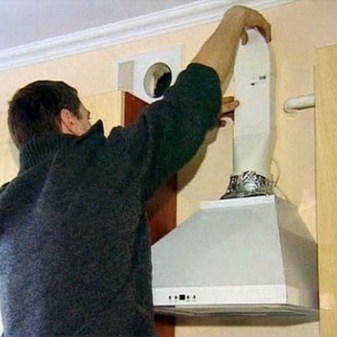
- It is strongly recommended to ground the socket into which the device will be connected. This is due to the contact of the electrical appliance with water vapor and drops of fat, which, in the event of a malfunction of the hood's electrical equipment, can lead to a short circuit.
- When connecting the air duct to the general ventilation duct, install the grille.This will help maintain the ventilation gap and prevent the duct pipe from blocking it.

If you listen to these simple recommendations, the installation of a hood with a vent into the ventilation will be successful and will not cause difficulties even for people who have no such experience.
Operating rules
In order for the hood to last as long as possible, and its work was the most effective, it is recommended to carry out timely maintenance and follow the rules for using the device. Before you start cleaning the hood, you should disconnect it from the electrical network. When cleaning the case from dust and grease deposits, do not use abrasive detergents and compounds containing acids. It is better to purchase dishwashing liquid and stainless steel cleaner. The first will dissolve grease stains, and the second will give the product its original shine and cleanliness.

Hoods of this type are equipped with two types of grease filters: metal or acrylic. The former should be washed a couple of times a month in a dishwasher or under running warm water using liquid detergents. If the filter is made of aluminum, it is recommended to rinse it in cool water using dishwashing detergent or laundry soap. Acrylic filters cannot be cleaned: they should be replaced with new ones every three months. After cleaning the device, you need to wait until the washed elements are completely dry, and only then connect it to the mains.

Hoods with ventilation ducts are modern high-tech representatives of ventilation systems. Appliances provide an effective outflow of polluted air, make your stay in the kitchen pleasant and comfortable.
For information on how to install a kitchen hood with a vent into the ventilation, see the next video.













The comment was sent successfully.